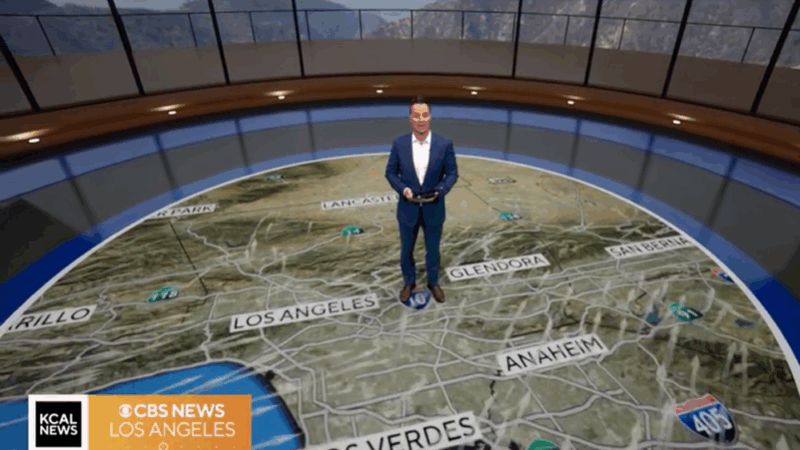Gray and CBS Stations Unveil Cutting-Edge AR/VR Studio Overhauls with LED Technology

Advancements in Studio Technology: AR, VR, and LED Walls
Augmented reality (AR) graphics, virtual sets, and large video walls made of high-resolution LED displays are becoming increasingly popular among local stations aiming to enhance their studio presentation technology. These innovations are transforming the way news is produced and delivered, offering more dynamic and immersive experiences for viewers.
CBS News and Stations has been at the forefront of this trend, implementing large AR/VR sets across eight markets. This includes KCAL Los Angeles and KTVT Dallas-Ft. Worth, with additional stations such as San Francisco, New York, Chicago, Philadelphia, Denver, and Miami also utilizing these advanced setups. The AR/VR sets feature curved green-screen backgrounds that extend onto the floor, creating sophisticated 3D virtual environments.
Gray Media’s Fox affiliate WVUE New Orleans has also embraced cutting-edge technology in its new facility, which went on-air in May. The station features two separate studios, each equipped with large LED walls, green screens, and dedicated control rooms. These studios produce a mix of news, lifestyle programming, and sports content for Gulf Coast Sports and Entertainment Network (GCSEN), Gray’s broadcast sports network.
Incremental Improvements in Studio Technology
While complete studio overhauls like those at CBS and Gray are impressive, many stations are opting for smaller, incremental upgrades. Gary Levitt, VP of sales and marketing for FX Design Group, notes that stations are often looking to "embellish the existing hard set" with virtual components rather than replacing it entirely. This can include roll-down green screens, chroma walls, or even the integration of large LED walls.
Levitt attributes this shift to advancements in technology and the decreasing cost of LED walls. As prices have dropped significantly over the years, stations are finding it more financially viable to incorporate these elements into their existing setups. Software companies like Brainstorm have also played a role in making AR/VR technology more accessible, simplifying the design and rendering of photorealistic 3D graphics.
Flexibility and Cost-Effectiveness of LED Walls
LED walls offer graphic designers and content producers a versatile medium for motion graphics, allowing for quick reconfiguration of a set's look. When a station adds a large LED wall to an existing set area, modifications may be necessary to accommodate the LED tiles, including work on the top, bottom, and sides of the wall.
The resolution of LED walls is measured by pixel pitch, with smaller numbers indicating higher resolution. Most studios using LED walls are opting for a 1.5 mm pixel pitch, which offers a balance between quality and affordability. However, some stations with larger budgets may choose a 1.2 mm pitch for even higher resolution.
A New View for WVUE
WVUE has implemented several large high-resolution LED walls across its two studios, along with various standard LED monitors. Graphics for all the LED displays are produced in 4K using Vizrt Viz Engine systems, ensuring high-quality visuals. The station's goal was to create a flexible environment where either studio could quickly transition from a newscast to a lifestyle show or a sports program.
Since its move to the new building, WVUE has experienced increased flexibility and improved presentation quality. The ability to run simultaneous live productions has proven invaluable, as demonstrated when the station covered both an NBA draft special and a College World Series championship celebration on the same night.
Green-Screen Wave for CBS
CBS News and Stations is pursuing production flexibility through large green-screen sets that can create complete virtual environments for both linear broadcasts and streaming programming. The first station to launch this setup was KPIX San Francisco, which has since expanded into hard news and sports coverage. The virtual set runs on Zero Density software and Epic Games’ Unreal Engine rendering, featuring a spacious green-screen background painted with special "ChromaLight" paint.
Meteorologists use a proprietary touchscreen interface to control weather graphics on an iPad, while also having access to AR graphics such as 3D topographical elements. The KPIX virtual set, along with a companion studio at WCBS New York, is used to produce CBS 24/7, a national streaming show covering breaking news globally.
Lighting in an LED World
Studio lighting has seen significant improvements over the years, with the shift from incandescent to fluorescent bulbs and now to LEDs. This transition has led to greater efficiency and reduced power consumption. LED fixtures also offer superior color accuracy and controllability, with modern LEDs achieving a CRI above 95.
Variable white technology allows for dynamic adjustment of color temperature, enabling better matching of ambient light or setting the mood for different shows. Control systems like DMX support multiple channels, facilitating automated scene playback and greater flexibility in lighting setups.
LEDs in the Sky
Alfalite has introduced Skypix RGBW, a series of ceiling-mounted LED panels designed for virtual production and extended reality environments. These panels combine RGB video playback with an integrated white lighting channel, delivering more natural scenes from above. The Skypix panel features a 3.9 mm pixel pitch, high brightness, and a wide color temperature range, making it ideal for studio lighting.
Skypix also includes Invisible Marker (IM) technology, which works with optical camera tracking systems without the need for physical markers. This innovation simplifies the setup process and enhances the accuracy of virtual production.
Post a Comment for "Gray and CBS Stations Unveil Cutting-Edge AR/VR Studio Overhauls with LED Technology"
Post a Comment